美国南北战争(英文版)
- 格式:pptx
- 大小:1.63 MB
- 文档页数:16

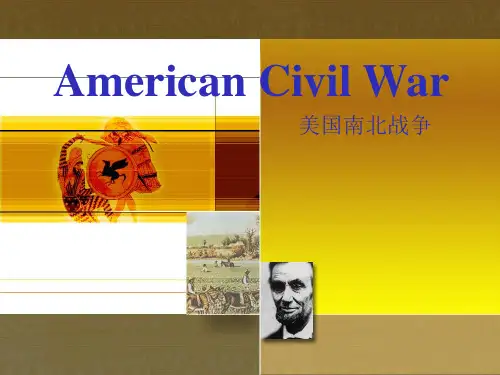

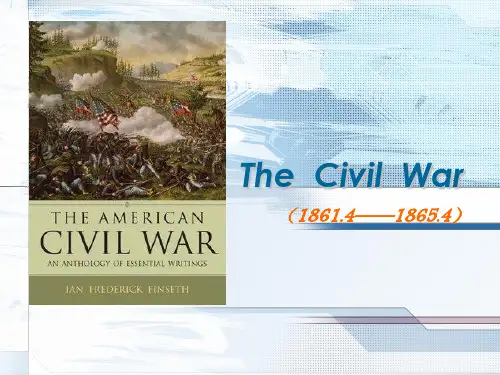
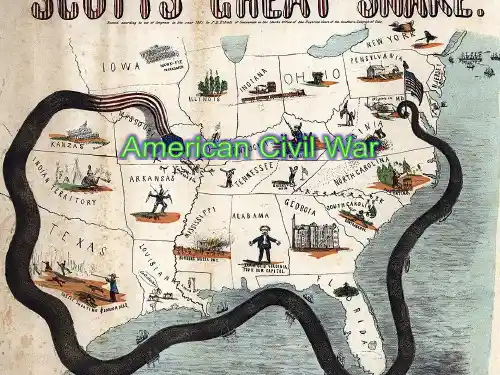

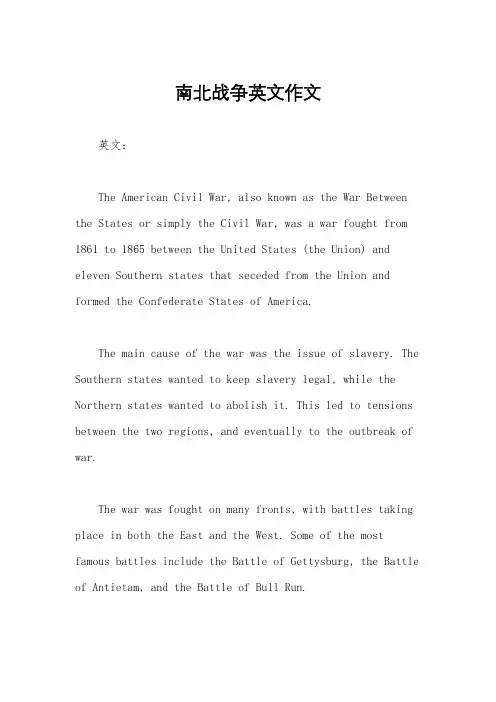
南北战争英文作文英文:The American Civil War, also known as the War Between the States or simply the Civil War, was a war fought from 1861 to 1865 between the United States (the Union) and eleven Southern states that seceded from the Union and formed the Confederate States of America.The main cause of the war was the issue of slavery. The Southern states wanted to keep slavery legal, while the Northern states wanted to abolish it. This led to tensions between the two regions, and eventually to the outbreak of war.The war was fought on many fronts, with battles taking place in both the East and the West. Some of the most famous battles include the Battle of Gettysburg, the Battle of Antietam, and the Battle of Bull Run.In the end, the Union emerged victorious, and slavery was abolished throughout the United States. However, the war had a lasting impact on the country, with many Southerners feeling bitter and resentful towards the North for years to come.中文:美国内战,也被称为州际战争或简称为内战,是一场于1861年至1865年之间在美国联邦和11个南方州之间进行的战争,这些州退出联邦并组成了美利坚联盟国。
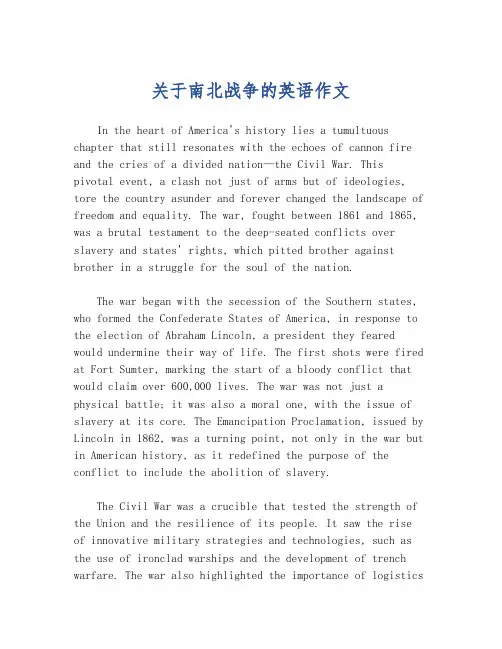
关于南北战争的英语作文In the heart of America's history lies a tumultuous chapter that still resonates with the echoes of cannon fire and the cries of a divided nation—the Civil War. Thispivotal event, a clash not just of arms but of ideologies, tore the country asunder and forever changed the landscape of freedom and equality. The war, fought between 1861 and 1865, was a brutal testament to the deep-seated conflicts over slavery and states' rights, which pitted brother against brother in a struggle for the soul of the nation.The war began with the secession of the Southern states, who formed the Confederate States of America, in response to the election of Abraham Lincoln, a president they feared would undermine their way of life. The first shots were fired at Fort Sumter, marking the start of a bloody conflict that would claim over 600,000 lives. The war was not just a physical battle; it was also a moral one, with the issue of slavery at its core. The Emancipation Proclamation, issued by Lincoln in 1862, was a turning point, not only in the war but in American history, as it redefined the purpose of the conflict to include the abolition of slavery.The Civil War was a crucible that tested the strength of the Union and the resilience of its people. It saw the rise of innovative military strategies and technologies, such as the use of ironclad warships and the development of trench warfare. The war also highlighted the importance of logisticsand industry, with the North's superior resources and infrastructure giving it a significant advantage.As the war drew to a close with the surrender of General Robert E. Lee at Appomattox Court House, the nation faced the daunting task of reconstruction. The 13th Amendment, abolishing slavery, was ratified, marking the end of a brutal institution that had divided the country for so long. Yet, the road to healing was long and fraught with challenges, as the legacy of the war continued to shape American society and politics for generations to come.The Civil War remains a defining moment in American history, a time of immense sacrifice and profound change. It is a story of courage and conviction, of tragedy and transformation, and a reminder that the ideals of freedom, justice, and equality are hard-won and must be continually upheld.。
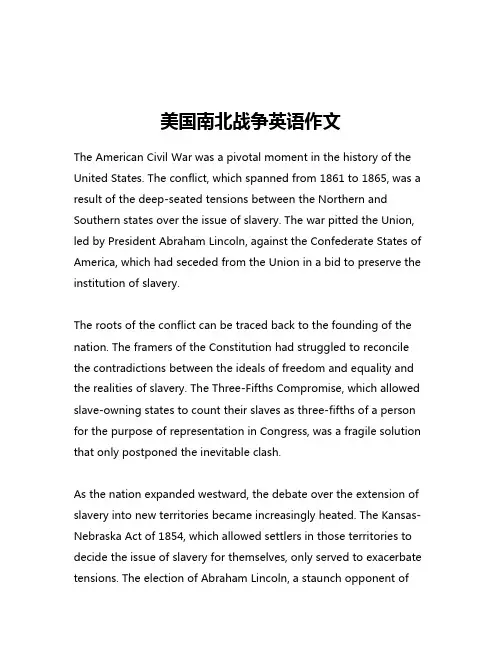
美国南北战争英语作文The American Civil War was a pivotal moment in the history of the United States. The conflict, which spanned from 1861 to 1865, was a result of the deep-seated tensions between the Northern and Southern states over the issue of slavery. The war pitted the Union, led by President Abraham Lincoln, against the Confederate States of America, which had seceded from the Union in a bid to preserve the institution of slavery.The roots of the conflict can be traced back to the founding of the nation. The framers of the Constitution had struggled to reconcile the contradictions between the ideals of freedom and equality and the realities of slavery. The Three-Fifths Compromise, which allowed slave-owning states to count their slaves as three-fifths of a person for the purpose of representation in Congress, was a fragile solution that only postponed the inevitable clash.As the nation expanded westward, the debate over the extension of slavery into new territories became increasingly heated. The Kansas-Nebraska Act of 1854, which allowed settlers in those territories to decide the issue of slavery for themselves, only served to exacerbate tensions. The election of Abraham Lincoln, a staunch opponent ofthe expansion of slavery, in 1860 was the final straw for the Southern states, which seceded from the Union and formed the Confederate States of America.The war that followed was a bloody and brutal affair. The Union, with its superior manpower and industrial might, ultimately prevailed, but not without a tremendous cost in lives and suffering. The Battle of Gettysburg, fought in July 1863, was a pivotal moment in the war, with the Union forces holding their ground against the Confederate onslaught and turning the tide of the conflict.The Emancipation Proclamation, issued by Lincoln in 1863, was a game-changer, transforming the war from a struggle to preserve the Union to a crusade to end slavery. The Thirteenth Amendment, ratified in 1865, officially abolished slavery throughout the United States, marking a momentous step forward in the country's long and difficult journey towards racial equality.The legacy of the Civil War is a complex and often contentious one. The sacrifices made by both sides have been commemorated and memorialized in countless ways, from the towering monuments of the National Mall to the countless small communities that bear the scars of the conflict. The war also left an indelible mark on the national psyche, shaping the way Americans understand their history and their identity.Today, as the country grapples with the ongoing challenges of racial justice and social inequality, the lessons of the Civil War remain as relevant as ever. The struggle to uphold the ideals of freedom and equality, in the face of powerful forces of oppression and division, is a battle that continues to be fought in the hearts and minds of all Americans. It is a testament to the enduring strength and resilience of the American spirit, and a reminder that the path to true progress is often paved with sacrifice and struggle.。

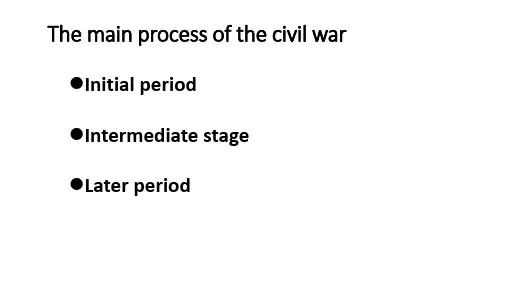
Gone with the wind1861-1865年,美国爆发内战,交战双方分别是南部奴隶主和北部的资产阶级,因而历史上又称“南北战争”。
南北战争是美国历史上的另一个转折点,尽管就平时我们所知,这场战争是正面的,说是黑人的解放战争,是美国历史上的飞跃。
而小说中写道,很多南方黑奴都是不情愿被解放的,他们和白人之间处的很好,压根就是白人和白人的战争,看不到一点白人奴隶主和黑人之间的矛盾。
南方的黑人和奴隶主一样在战场上捍卫南方的庄园和曾经的奢华。
因为他们从来就认为那是他们的生活,不应该改变,是北方人打扰了他们平静的生活。
我们看到黑妈妈怒骂北方佬,还有其他的黑奴们一样对他们的庄园主必恭必敬,因为他们在共同的土地上生活,他们在战争的灾难中相依为命,同舟共济。
斯嘉丽:一个猫一样的女人。
有着猫一样的目光,猫一样的微笑,猫一样的步伐和猫一样的敏捷。
第一她在困难的时候敢于承担责任,虽然也有动摇,但最后仍然承担责任,比如她救了媚兰,她重振塔拉庄园,后来长期扶助艾希礼一家等等。
第二她敢于去爱、无怨无悔,她的整个青春都在爱着艾希礼,没有回报但她仍没有放弃努力,直到能力的极限为止。
第三知错能改,当她最后明白她之前所为是错误时,她马上向瑞德道歉,请求原谅。
《乱世佳人》(GONE WITH THE WIND)是好莱坞影史上最值得骄傲的一部旷世巨片,影片放映时间长达4小时,观者如潮。
其魅力贯穿整个20世纪,因此有好莱坞“第一巨片”之称。
影片当年耗资400多万美元,历时三年半完成,其间数换导演,银幕上出现了60多位主要演员和9000多名配角演员。
在1939年的第12届奥斯卡奖中一举夺得八项金像奖,轰动美国影坛。
这部耗资巨大,场景豪华,战争场面宏大逼真的历史巨片,以它令人称道的艺术成就成为美国电影史上一部经典作品,令人百看不厌。
1861年南北战争爆发的前夕,塔拉庄园的千金小姐思嘉爱上了另一庄园主的儿子艾希礼,但艾希礼却选择了自己的表妹——温柔善良的媚兰为终身伴侣。
美国南北战争PPT英文内容The start of the American Civil WarThe Battle of Fort Sumter(萨姆特堡战役)This is Fort Sumter, where the shots that started the American Civil War were fired on April 12, 1861.The first stage of the warThe North had developed industry and larger population than the South, but the South was much well prepared than the North. As a result, the North was defeated easily and suffered great losses in the eastern part of the theater, such as the Battle of Manassas and the Peninsula Campaign, though the North won several battles in the western theater.In the case of military failures of the North, Republican activists claimed emancipation and arming of blacks. Lincoln was also aware of the necessity of the emancipation of slaves.The second stage of the warIn 1862, the North attacked the South in the western part of the theater, and won several battles. In June, the North liberated the Kentucky and T ennessee.The Battle of Sharpsburg (also known as Battle of Antietam) erupted on September 17, 1862, which is the bloodiest single-day battle in American history. Losses for the day were heavy on both sides. The North had 12,401 casualties with 2,108 dead. The South had 10,318 casualties with 1,546 dead.The South was defeated but the war was still very though to the North.To win the war earlier, Lincoln's Government adopted a series of measures and policies.Homestead Act was issued in 1862,which helped the North to get solid financial support, and win the war in the end.The Emancipation Proclamation was issued by Lincoln on September 22, 1862, which announced the liberation of slaves and allowed the black people to join the army of the North.This action helped the North to get more supports and attracted more and more black people to flee from and then attack the South.During 1862 and 1863, black people, who mainly fled from the South, were armed to fight against the South.On July 1, 1863, the two sides battled at Gettysburg, and the South was defeated finally. Both of the two sides suffered great losses, but the initiative on the battlefield turned into the hands of North and this battle became the turning point of the Ameriacn Civil War.Almost at the same time, the Confederate defense surrounded by the North since February,1863 at Vicksburg,which was vital to the control the Mississippi River and the railway networks of western America,finally surrendered on July 4. They had eaten up all what they could get, including cats, rats and snakes, before they gave in.In 1864, the North adopt to new strategy and started attacking the South in two directions at the same time. In the eastern part of the theater, wearing down the enemy forces was the main goal. And in the western part of the theater, the North tried to penetrate enemy hinterland and cut off the links of "Confederacy" between the Northeast and the Southwest.In September, the North captured Atlanta and two monthslater the famous "March to the sea" began, the March completely destroyed various military and civilian facilities of the enemy, so that the economies of the South came to a standstill. In the east part of the theater, the North drove the enemy to the rebel "capital" Richmond.In early 1865, the South's plantation economy was just near a crash, because most slaves had fled and the North imposed a naval blockade since 1861, which at last almost cut off the South's trade with Europe. The blockade was the Union Blockade, which was raised by Winfield Scott.Deserters of the South was growing rapidly. What's more, weapons, food and daily necessities were all scarce. Finally on April 9, 1865, the Confedrate army surrounded by the North gave in. The American Civil War came to the end.。
关于美国南北战争的英语演讲稿篇一:美国内战中英文介绍1.Civil WarThe American Civil War (1861–1865), often referred to simply as The Civil War in the United States, was a civil war fought in the United States of America. In response to the election of Abraham Lincoln as President of the United States, 11 southern slave states declared their secession from the United States and formed the Confederate States of America ("the Confederacy"); the other 25 states supported the federal government ("the Union"). After four years of warfare, mostly within the Southern states, the Confederacy surrendered and slavery was outlawed everywhere in the nation. Issues that led to war were partially resolved in the Reconstruction Era that followed, though others remained uesolved.In the presidential election of 1860, the Republican Party, led by Abraham Lincoln, had campaigned against expanding slavery beyond the states in which it already existed. The Republicans strongly advocated nationalism, and in their 1860 platform theydenounced threats of disunion as avowals of treason. After a Republican victory, but before the new administration took office on March 4, 1861, seven cotton states declared their secession and joined to form the Confederate States of America. Both the outgoing administration of President James Buchanan and the incoming administration rejected the legality of secession, considering it rebellion. The other eight slave states rejected calls for secession at this point. No country in the world recognized the Confederacy.Hostilities began on April 12, 1861, when Confederate forces attacked a military installation at Fort Sumter in South Carolina. Lincoln responded by calling for a volunteer army from each state to recapture federal property, which led to declarations of secession by four more slave states. Both sides raised armies as the Union seized control of the border states early in the war and established a naval blockade. Land warfare in the East was inconclusive in 1861–62, as the Confederacy beat back Union efforts to capture its capital, Richmond, Virginia, notably during the Peninsular Campaign. In September 1862, theConfederate campaign in Maryland ended in defeat at the Battle of Antietam, which dissuaded the British from intervening.[2] Days after that battle, Lincoln issued the Emancipation Proclamation, which made ending slavery a war goal.[3]In 1863, Confederate general Robert E. Lee's northward advance ended in defeat at the Battle of Gettysburg. To the west, the Union gained control of the Mississippi River after the Battle of Shiloh and Siege of Vicksburg, splitting the Confederacy in two and destroying much of their western army. Due to his western successes, Ulysses S. Grant was given command of the eastern army in 1864, and organized the armies of William Tecumseh Sherman, Philip Sheridan and others to attack the Confederacy from all directions, increasing the North's advantage in manpower. Grant restructured the union army, and put other generals in command of divisions of the army that were to support his push into Virginia. He fought several battles of attrition against Leethrough the Overland Campaign to seize Richmond, though in the face of fierce resistance he altered hisplans and led the Siege of Petersburg which nearly finished off the rest of Lee's army. Meanwhile, Sherman captured Atlanta and marched to the sea, destroying Confederate infrastructure along the way. When the Confederate attempt to defend Petersburg failed, the Confederate army retreated but was pursued and defeated, which resulted in Lee's surrender to Grant at Appomattox Court House on April 9, 1865.The American Civil War was one of the earliest true industrial wars. Railroads, the telegraph, steamships, and mass-produced weapons were employed extensively. The practices of total war, developed by Sherman in Georgia, and of trench warfare around Petersburg foreshadowed World War I in Europe. It remains the deadliest war in American history, resulting in the deaths of 620,000 soldiers and an undetermined number of civilian casualties. Historian John Huddleston estimates the death toll at ten percent of all Northern males 20–45 years old, and 30 percent of all Southern white males aged 18–40.[4] Victory for the North meant the end of the Confederacy and of slavery in the United States, and strengthened the roleof the federal government. The social, political, economic and racial issues of the war decisively shaped the reconstruction era that lasted to 1877.美国南北战争(1861-1865),通常被称为在美国南北战争,是一场内战,战斗在美利坚合众国。
南北战争的英文书
1."The Civil War: A Narrative" by Shelby Foote: 这本书是美国内战最全面的历史叙述,以其生动的叙述和深入的研究而著名。
2."The Emancipation Proclamation" by Ira Berlin: 这本专注于林
肯的解放宣言,以及它如何改变战争和美国。
3."Bury My Heart at Wounded Knee: An Indian History of the American West" by Dee Brown: 虽然这本书主要关注美国西部开拓史,但它也涵盖了南北战争前的一些
事件,提供了对土著美国人经历的独特见解。
4."The Penguin History of the United States of America" by Mark C. Carnes: 这本书全面概述了美国的历史,包括南北战争的部分。